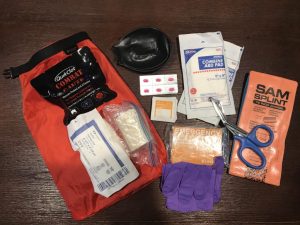April is Pet First Aid Awareness Month
ALL images and text created by Bailey Keating
When my dog Miles sees me emerge from the basement with hiking gear in hand, he follows at my heels. He knows we will be heading to the mountains soon and he is always anxious that I might forget him (even though that has NEVER happened!). He will jump at the first opportunity to sneak out the door and sit in the car although he hates LONG car rides. He can never sit still, and his anxious cries eventually turn into excited barks. He loves to hike because it’s a day spent adventuring with me, his Mom. I love to hike because it brings him joy, exercise, and freedom. Miles is my 3-year-old Goldendoodle and hiking companion extraordinaire.

Eagle Rock. Greenville, ME. August 2018
Moosehead Pinnacle Pursuit Hiking Challenge
He has been tackling mountains since he was six months old, well before I had considered all his hiking needs. A few situations later and I’ve made first aid a priority. I plan for FOUR dangers- toxins, traumatic injuries, temperature, & other creatures. Here’s how:
TOXINS– This category includes parasites, poisons, diseases, ticks, insects, not-so-edible stuff and other things you don’t want near your dog. This is an easy category to prepare for before hitting the trail.
- Vaccinate– Some optional vaccines like Lyme & Leptospirosis are an absolute MUST for hiking companions. Ask your vet!
- Preventatives– Treat against fleas, ticks, and heartworm.
- Did you know heartworm is spread by mosquitos?
- ALWAYS perform a “tick check” after hiking!
- Insect Repellent- All natural & dog safe could be helpful.
- Train– Hiking dogs need a flawless “Leave it” and/or “Drop it” command. You should always try to prevent your dog from eating or drinking things they find outside. For example: Streams could be contaminated with bacterial diseases.
TRAUMATIC INJURIES- Injuries can be so SCARY! No one wants their hiking companion to be injured but a good first aid kit and first aid training can help.
- Trail selection– Pick your hikes with your dog in mind- sharp rocks, obstacles, and ledges can all pose real dangers while hiking. Do your research, bring boots as needed for footing hazards and know your dog’s limits.
- Train– Off-leash dogs need a flawless “recall”. Trust me… dogs don’t look at a ledge and say, “That looks dangerous.”
- HIKING FIRST AID KIT for your DOG:
- Disposable gloves- for you to wear while providing first aid.
- Alcohol wipes- hydrogen peroxide can be used instead.
- Gauze pads- ABD Pads 5”x9” are my favorite. Big gauze can be cut to fit your needs.
- Cling Bandage- Like ACE/Vet Wrap/CoFlex/Rolled Gauze (something that won’t stick to fur). Forget the tape.
- Hemostatic Agent- QuikClot is my favorite for stopping blood loss in large wounds.
- Scissors- preferably with a blunt end.
- Splint- I carry a SAMs splint- it can be cut & molded to the perfect size & shape.
- Medications- Bring daily medications as needed, Benadryl for allergic reactions, Hydrogen Peroxide w/syringe for inducing vomiting. Ask your vet for more information.
- Muzzle- An injured dog will be in pain and scared. They might not want you to touch their injuries. Even an ACE bandage could work as a make-shift muzzle if need be.
- Boots- actual dog boots or PAWZ for dressing a foot injury in the summer.
- Jacket- winter hiking or rain consideration. Emergency blanket??
- Exit Strategy- If your dog can’t walk and you don’t have cell phone service…WHAT IS YOUR PLAN?? Do you need a harness to carry your dog?
**There is no such thing as a perfect first aid kit, so you’ll need to consider your personal needs and first aid skills. The more versatile and multipurpose your supplies are the less you’ll have to carry. Most first aid supplies can be used on dogs AND humans!**

I carry a few extra things for myself that are not pictured here.
TEMPERATURE– The hot weather can be your WORST enemy! (Let’s think summer and not talk about COLD weather yet.)
- Weather– Check the weather and avoid poor weather conditions.
- EATS– Bring enough WATER!!! Food and treats. Your dog wants trail snacks just like you. NEVER leave without ample food and water (and don’t forget a bowl).
- Trail selection-Consider picking a hike with swimming opportunities and lots of shade.
- Distance– Base the distance of your hike off the weather and what your dog can safely handle.
- Rest– Take breaks while hiking to eat, drink, and rest.
- Medical– Look for signs of overheating and exhaustion- excessive panting, loud breathing sounds, foaming saliva, lethargy, lagging behind, or laying down. TURN BACK NOW!

Big Moose Mtn. Greenville, ME- August 2018
Moosehead Pinnacle Pursuit Hiking Challenge
OTHER CREATURES– From humans to bears consider who or what else could be on the trail with you. Last summer we ran into a moose and I’ve never been more grateful that Miles recalled flawlessly!
- Train– In this scenario your dog still needs a flawless “recall” if hiking off-leash.
- Leash– Always carry a leash. It is BEST PRACTICE to ALWAYS leash your dog in the presence of others. Not everyone likes dogs and not all dogs are “dog friendly”. It is simple to leash your dog and it ensures safety!!
- Identification– ID Tags, Microchip, Photo ID are great to have handy in case your dog runs off or gets lost.
- Alert others– Consider having your dog wear a bell to alert others or scare away animals.
- Be Visible– Make sure you and your dog wear reflective vests during hunting season.
- Leave No Trace– Poop bags to carry your dog’s waste or a trowel to bury it.
About Bailey Keating: Bailey is a firefighter/paramedic with experience assisting injured hikers. She loves the mountains and hiking with her dog is one of her favorite hobbies.
ALL images and text created by Bailey Keating



